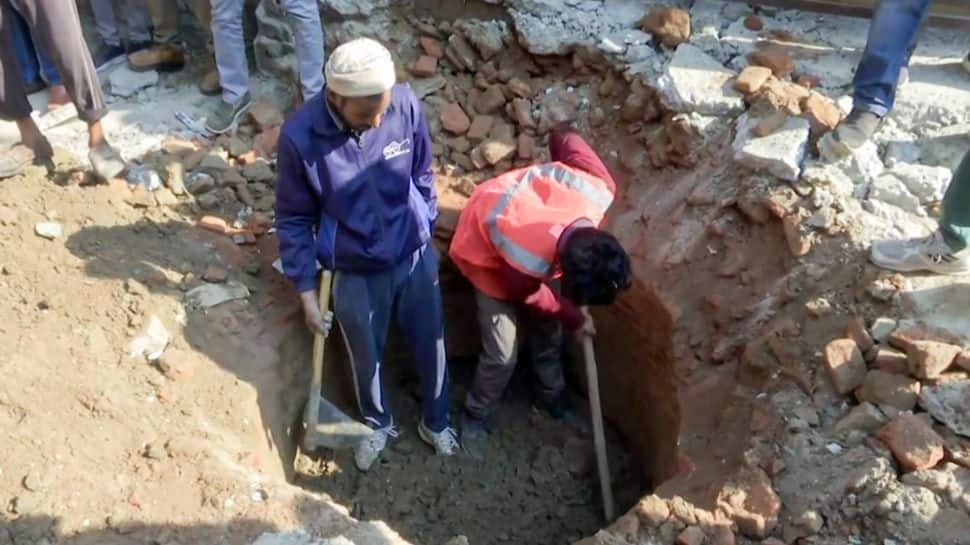 |
|
The recent archaeological survey in Sambhal, Uttar Pradesh, has unearthed a significant historical site, revealing a complex interplay of religious history, political tensions, and legal complexities. A four-member team from the Archaeological Survey of India (ASI) meticulously investigated a newly discovered temple, five 'teerths' (sacred water bodies), and nineteen wells, spanning a total of twenty-four areas over eight to ten hours. The district magistrate, Dr. Rajender Pensiya, highlighted the importance of the survey and the anticipated detailed report from the ASI, promising deeper insights into the historical and cultural significance of these findings. The primary focus of the survey was the Shri Kartik Mahadev Temple (also known as the Bhasma Shankar Temple), a structure that has been shrouded in mystery and inaccessibility for decades.
The reopening of the Shri Kartik Mahadev Temple after its closure since 1978 is a pivotal event. The closure stemmed from communal riots that resulted in the displacement of Hindu families and made the temple inaccessible. Its rediscovery during an anti-encroachment drive near the Shahi Jama Masjid is particularly noteworthy, given the charged atmosphere in the area. This rediscovery is not merely an archaeological event; it's deeply intertwined with the socio-political fabric of Sambhal. The recent violence in the area, including clashes between police and residents over a court-ordered survey of the Shahi Jama Masjid, further underscores the sensitive nature of this discovery. The violence resulted in five fatalities and injuries to twenty police officers, illustrating the tense environment in which the temple’s reopening took place and the delicate balance that needs to be maintained to ensure peace and order.
The request for carbon dating of the temple and wells underlines the significance of accurately determining the age of these structures. Carbon dating will offer invaluable chronological data, helping historians and archaeologists to better understand the historical context of the temple and the wells within the broader history of Sambhal. This scientific approach is crucial for establishing the precise timeline of these sites and for understanding their role in the region's cultural and religious evolution. The results from the carbon dating analysis will likely be critical in determining the overall historical significance of the newly discovered sites, adding another layer of complexity and intrigue to the narrative surrounding the temple and its surroundings.
The Supreme Court's intervention in November, directing civil courts to halt fresh legal challenges to the ownership or title of religious places and surveys under the Places of Worship Act of 1991, adds another layer of legal and political context to the situation. This intervention signals the Court’s awareness of the potential for such issues to escalate, leading to conflict and further inflaming already tense social and political dynamics. The Court’s ruling reflects a larger effort to avoid further escalation of religious tensions and conflicts over the ownership and control of religious sites. The situation highlights a complex interplay between religious sentiments, historical artifacts, and legal frameworks governing such matters. The reopening of the temple, therefore, stands not only as an archaeological discovery, but also as a symbolic event potentially influencing future relations between different communities in the region.
In conclusion, the archaeological discovery in Sambhal is not simply about the unearthing of an ancient temple and wells; it’s a multifaceted event embedded within a complex web of historical narratives, contemporary socio-political tensions, and legal interventions. The reopening of the Shri Kartik Mahadev Temple, after decades of closure due to communal violence, is symbolic of the potential for reconciliation and healing, yet also serves as a reminder of the ongoing challenges in maintaining communal harmony and peace in the region. The ASI's detailed report, combined with the results of carbon dating, promises to shed more light on this significant historical site and its role within the larger context of the region’s history and cultural heritage. The ongoing situation underscores the importance of careful management of historical sites and the critical need for sensitive engagement with diverse religious and cultural communities to prevent further conflict.
Source: ASI Discovers Ancient Temple, 19 Wells, And 5 Shrines During Survey Of 46-Year-Old Site In Sambhal
